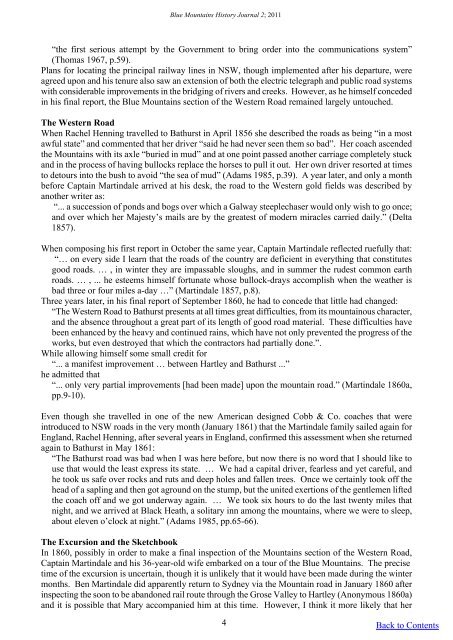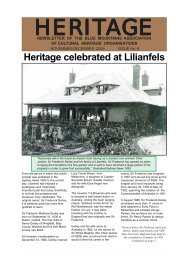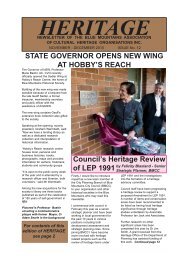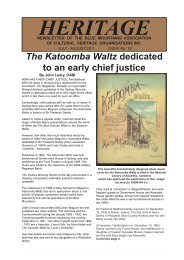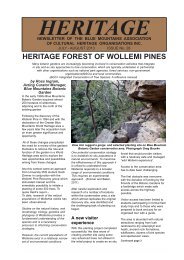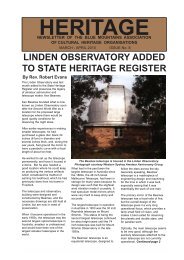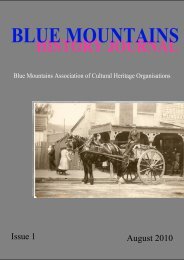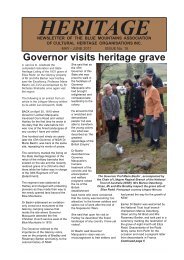Blue Mountains History Journal Issue 2
Blue Mountains History Journal Issue 2
Blue Mountains History Journal Issue 2
You also want an ePaper? Increase the reach of your titles
YUMPU automatically turns print PDFs into web optimized ePapers that Google loves.
<strong>Blue</strong> <strong>Mountains</strong> <strong>History</strong> <strong>Journal</strong> 2; 2011<br />
“the first serious attempt by the Government to bring order into the communications system”<br />
(Thomas 1967, p.59).<br />
Plans for locating the principal railway lines in NSW, though implemented after his departure, were<br />
agreed upon and his tenure also saw an extension of both the electric telegraph and public road systems<br />
with considerable improvements in the bridging of rivers and creeks. However, as he himself conceded<br />
in his final report, the <strong>Blue</strong> <strong>Mountains</strong> section of the Western Road remained largely untouched.<br />
The Western Road<br />
When Rachel Henning travelled to Bathurst in April 1856 she described the roads as being “in a most<br />
awful state” and commented that her driver “said he had never seen them so bad”. Her coach ascended<br />
the <strong>Mountains</strong> with its axle “buried in mud” and at one point passed another carriage completely stuck<br />
and in the process of having bullocks replace the horses to pull it out. Her own driver resorted at times<br />
to detours into the bush to avoid “the sea of mud” (Adams 1985, p.39). A year later, and only a month<br />
before Captain Martindale arrived at his desk, the road to the Western gold fields was described by<br />
another writer as:<br />
“... a succession of ponds and bogs over which a Galway steeplechaser would only wish to go once;<br />
and over which her Majesty’s mails are by the greatest of modern miracles carried daily.” (Delta<br />
1857).<br />
When composing his first report in October the same year, Captain Martindale reflected ruefully that:<br />
“… on every side I learn that the roads of the country are deficient in everything that constitutes<br />
good roads. … , in winter they are impassable sloughs, and in summer the rudest common earth<br />
roads. … , ... he esteems himself fortunate whose bullock-drays accomplish when the weather is<br />
bad three or four miles a-day …” (Martindale 1857, p.8).<br />
Three years later, in his final report of September 1860, he had to concede that little had changed:<br />
“The Western Road to Bathurst presents at all times great difficulties, from its mountainous character,<br />
and the absence throughout a great part of its length of good road material. These difficulties have<br />
been enhanced by the heavy and continued rains, which have not only prevented the progress of the<br />
works, but even destroyed that which the contractors had partially done.”.<br />
While allowing himself some small credit for<br />
“... a manifest improvement … between Hartley and Bathurst ...”<br />
he admitted that<br />
“... only very partial improvements [had been made] upon the mountain road.” (Martindale 1860a,<br />
pp.9-10).<br />
Even though she travelled in one of the new American designed Cobb & Co. coaches that were<br />
introduced to NSW roads in the very month (January 1861) that the Martindale family sailed again for<br />
England, Rachel Henning, after several years in England, confirmed this assessment when she returned<br />
again to Bathurst in May 1861:<br />
“The Bathurst road was bad when I was here before, but now there is no word that I should like to<br />
use that would the least express its state. … We had a capital driver, fearless and yet careful, and<br />
he took us safe over rocks and ruts and deep holes and fallen trees. Once we certainly took off the<br />
head of a sapling and then got aground on the stump, but the united exertions of the gentlemen lifted<br />
the coach off and we got underway again. … We took six hours to do the last twenty miles that<br />
night, and we arrived at Black Heath, a solitary inn among the mountains, where we were to sleep,<br />
about eleven o’clock at night.” (Adams 1985, pp.65-66).<br />
The Excursion and the Sketchbook<br />
In 1860, possibly in order to make a final inspection of the <strong>Mountains</strong> section of the Western Road,<br />
Captain Martindale and his 36-year-old wife embarked on a tour of the <strong>Blue</strong> <strong>Mountains</strong>. The precise<br />
time of the excursion is uncertain, though it is unlikely that it would have been made during the winter<br />
months. Ben Martindale did apparently return to Sydney via the Mountain road in January 1860 after<br />
inspecting the soon to be abandoned rail route through the Grose Valley to Hartley (Anonymous 1860a)<br />
and it is possible that Mary accompanied him at this time. However, I think it more likely that her<br />
4 Back to Contents


